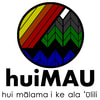|
Piʻi i uka.Continue the ascent to the Wao Maʻukele.
|
KulaHere we enter in to the ʻāina kula as we continue our journey along the ala ʻūlili. The kula is in the wao kanaka region, where kānaka lived and cultivated the ʻāina (See Māhele ʻĀina Records). In this part of Hāmākua, as in much of Hawaiʻi, kalo and ʻuala were the most commonly cultivated food crops. Kalo was historically known to have been cultivated here in "pā kukui," clearings in the kukui forests that are said to have once covered this region (Native Planters). Interestingly enough, māmaki seems to have been one of the most common non-food crops cultivated in this area, likely for its utility in making kapa.
This region has been completely transformed over the past 150 years by sugar cane plantations, which served to displace a majority of the Kānaka of these ʻāina. Sugar production continued here in to the mid 1990s, however, today, these ʻāina are covered in eucalyptus trees |
|
Hoʻi i ke ala ʻūlili.Return to the Ala ʻŪlili.
|
Iho i kai.Descend to the Kahakai.
|
